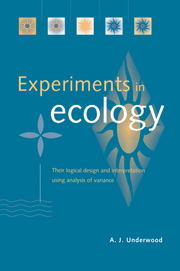Book contents
- Frontmatter
- Contents
- Acknowledgements
- 1 Introduction
- 2 A framework for investigating biological patterns and processes
- 3 Populations, frequency distributions and samples
- 4 Statistical tests of null hypotheses
- 5 Statistical tests on samples
- 6 Simple experiments comparing the means of two populations
- 7 Analysis of variance
- 8 More analysis of variance
- 9 Nested analyses of variance
- 10 Factorial experiments
- 11 Construction of any analysis from general principles
- 12 Some common and some particular experimental designs
- 13 Analyses involving relationships among variables
- 14 Conclusions: where to from here?
- References
- Author index
- Subject index
4 - Statistical tests of null hypotheses
Published online by Cambridge University Press: 05 June 2012
- Frontmatter
- Contents
- Acknowledgements
- 1 Introduction
- 2 A framework for investigating biological patterns and processes
- 3 Populations, frequency distributions and samples
- 4 Statistical tests of null hypotheses
- 5 Statistical tests on samples
- 6 Simple experiments comparing the means of two populations
- 7 Analysis of variance
- 8 More analysis of variance
- 9 Nested analyses of variance
- 10 Factorial experiments
- 11 Construction of any analysis from general principles
- 12 Some common and some particular experimental designs
- 13 Analyses involving relationships among variables
- 14 Conclusions: where to from here?
- References
- Author index
- Subject index
Summary
Why a statistical test?
From the earlier account of the logic of experimentation, it is not clear why we might need statistical tests. There could well be null hypotheses that require very straightforward, invariant observations to cause their rejection. For example, the null hypothesis ‘There are no squirrels in this forest’ can be rejected if someone sees a squirrel. The observations, model and hypothesis leading to this being the relevant null hypothesis are, however, hard to imagine. Most teachers of biology have long since learned not to make such categorically definitive statements. In my experience, stating that there are no crabs in a rock-pool leads almost immediately and universally to the unmistakable scuttling of (at least) one crab across the pool!
Our observations are, far more commonly, not ones that lead us to null hypotheses of such absolutes as ‘no entities present’. Usually, we are concerned with quantitative measurements. As explained above, these are rarely taken on such small, manageable populations that we can measure every unit in the population about which we are hypothesizing. We must therefore deal with samples. These can provide only statistical estimates of the required parameters of the population. They are subject to sampling error and are variable and inexact.
Consequently, any statement about them or conclusions drawn from them are themselves under the influence of the uncertainty inherent in the measurements. Dealing with this uncertainty involves trying to calculate how uncertain our conclusions are.
Information
- Type
- Chapter
- Information
- Experiments in EcologyTheir Logical Design and Interpretation Using Analysis of Variance, pp. 50 - 64Publisher: Cambridge University PressPrint publication year: 1996
Accessibility standard: Unknown
Why this information is here
This section outlines the accessibility features of this content - including support for screen readers, full keyboard navigation and high-contrast display options. This may not be relevant for you.Accessibility Information
- 1
- Cited by
